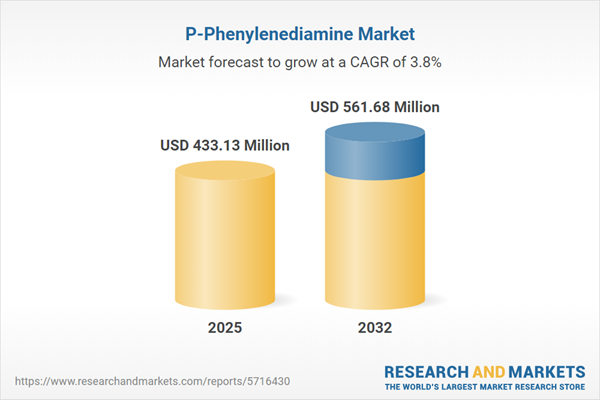Speak directly to the analyst to clarify any post sales queries you may have.
In a swiftly evolving specialty chemicals arena, the p-Phenylenediamine market offers a critical foundation for executive planning, enabling supply security and sustainable business operations across varied industries. Senior decision-makers depend on this market to enhance agility and manage compliance amid an environment of ongoing transformation.
Market Snapshot: p-Phenylenediamine Market Growth Outlook
The p-Phenylenediamine market is on a path of steady expansion, driven by consistent demand across the personal care, rubber manufacturing, and pharmaceutical sectors. Its adaptability enables organizations to respond effectively to shifting consumer needs and regulatory pressures. Major producers harness p-Phenylenediamine to reinforce product dependability and compliance, making it fundamental for standardizing quality in production processes. Accelerated adoption of digital supply chains and automation streamlines operations and supports smoother business model transitions. As these technologies continue to evolve, companies gain new tools to control costs, reduce risks, and position themselves competitively within the specialty chemicals industry.
Scope & Segmentation: Critical Strategic Dimensions
A deep understanding of the specialty chemicals value chain ensures senior leaders can drive optimization in procurement, logistics, and compliance. Comprehensive segmentation of the p-Phenylenediamine market delivers targeted visibility across production and distribution strategies, supporting robust decision-making and risk control.
- Form: Offered in both granule and powder formats, p-Phenylenediamine allows businesses manufacturing flexibility, enabling them to adapt their operations as product needs or specifications shift.
- Grade: Purity variations, including pharmaceutical and industrial grades, address complex certification and regulatory requirements, supporting access to advanced and regulated markets.
- End Use: Utilized across hair dyes, textiles, and rubber antioxidants, the market’s end uses require tailored supply chain support to ensure quality standards and meet sector-specific compliance objectives.
- Distribution Channel: Delivery through direct OEM sourcing, distributor partnerships, and digital procurement platforms offers diversified supply solutions, enhancing both market reach and supply risk mitigation.
- Regional Coverage: The market spans the Americas, Europe, Middle East and Africa, and Asia-Pacific, with each region requiring tailored strategies for regulatory alignment, local partnerships, and supply chain diversification.
- Leading Companies Reviewed: Competitive benchmarking includes Lanxess AG, Merck KGaA, Tosoh Corporation, Thermo Fisher Scientific Inc., Quzhou Fangda Chemical Industry Co. LTD., Shandong Yifan Chemical Technology Co. Ltd, Sichuan North Hongguang Chemical Co. Ltd, TBI Corporation Ltd., Aarti Industries Ltd., and Jay Organics Pvt. Ltd, outlining sector positioning and operational methodologies.
Key Takeaways for Senior Decision-Makers
- Implementation of continuous flow technologies and streamlined production workflows enables rapid pivots to new projects and evolving customer requirements, supporting adaptive manufacturing strategies.
- Sustainable synthesis approaches are increasingly prioritized, fostering improved alignment with environmental objectives and compliance frameworks across the specialty chemicals supply chain.
- Applying advanced process automation enhances supplier responsiveness and adaptation to quickly changing market and regulatory conditions.
- Strategic procurement using direct sourcing, strong distributor alliances, and digital platforms supports robust supply continuity and strengthens operational resilience.
- Broadening regional sourcing and diversifying feedstock origins, combined with digital risk monitoring, improves enterprise visibility and equips leaders to make timely decisions under regulatory challenges.
Tariff Impact and Market Dynamics
Recent tariff changes in the United States present new sourcing complexities for p-Phenylenediamine. Executive teams are responding by expanding supplier portfolios and building new partnerships, while leveraging distributor inventories to reduce risk and sustain uninterrupted operations.
Methodology & Data Sources
This market analysis draws insights from detailed interviews with industry leaders in personal care, rubber manufacturing, and pharmaceuticals. These insights are combined with regulatory documents and peer-reviewed studies to deliver actionable, validated planning support.
Why This Report Matters
- Enables procurement optimization and operational resilience, sustaining competitive strength within specialty chemicals markets.
- Bridges regulatory and sustainability imperatives, aligning leadership around environmental targets and digital transformation goals.
- Presents a structured and data-driven approach, allowing agile and confident decisions despite unpredictable industry shifts.
Conclusion
This outlook equips senior executives with actionable intelligence and clear strategies, ensuring proactive preparation as the p-Phenylenediamine sector evolves to meet new industry requirements.
Additional Product Information:
- Purchase of this report includes 1 year online access with quarterly updates.
- This report can be updated on request. Please contact our Customer Experience team using the Ask a Question widget on our website.
Table of Contents
3. Executive Summary
4. Market Overview
7. Cumulative Impact of Artificial Intelligence 2025
Companies Mentioned
The companies profiled in this P-Phenylenediamine market report include:- Lanxess AG
- Merck KGaA
- Tosoh Corporation
- Thermo Fisher Scientific Inc.
- Quzhou Fangda Chemical Industry Co.,LTD.
- Shandong Yifan Chemical Technology Co., Ltd
- ,Sichuan North Hongguang Chemical Co., Ltd
- TBI Corporation Ltd.
- Aarti Industries Ltd.
- Jay Organics Pvt. Ltd.
Table Information
| Report Attribute | Details |
|---|---|
| No. of Pages | 184 |
| Published | October 2025 |
| Forecast Period | 2025 - 2032 |
| Estimated Market Value ( USD | $ 433.13 Million |
| Forecasted Market Value ( USD | $ 561.68 Million |
| Compound Annual Growth Rate | 3.7% |
| Regions Covered | Global |
| No. of Companies Mentioned | 11 |









